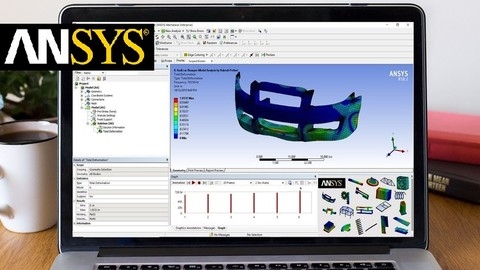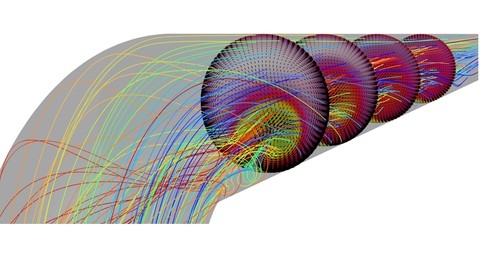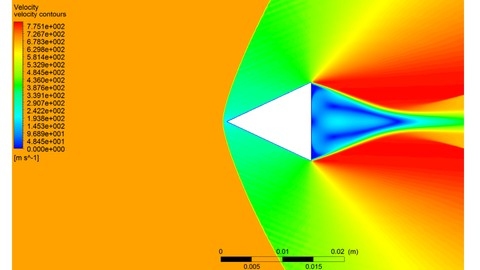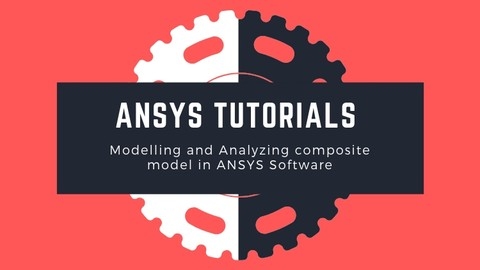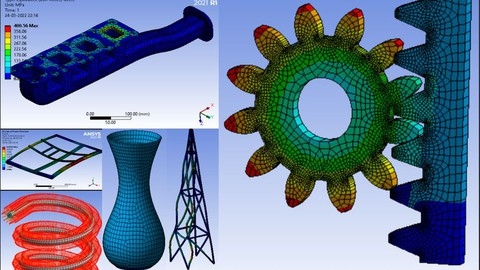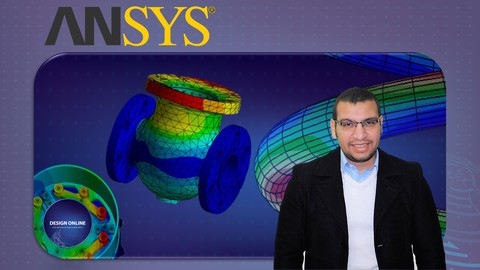ANSYS is a powerful suite of engineering simulation software used by professionals across various industries to analyze and optimize designs.
It employs the Finite Element Method (FEM), a numerical technique that breaks down complex structures into smaller elements for analysis, enabling engineers to simulate real-world scenarios and predict the behavior of components under different conditions.
By mastering ANSYS, you can unlock a world of possibilities, from designing efficient and robust structures to developing advanced products and optimizing manufacturing processes.
Finding a comprehensive and engaging ANSYS course on Udemy can be a daunting task.
With so many options available, it’s easy to feel overwhelmed and unsure where to start.
You’re looking for a course that provides a strong foundation in the software’s core features, equips you with practical skills, and guides you through real-world applications.
For the best ANSYS course overall on Udemy, we recommend ANSYS Training: An Easy Introduction with Applications.
This program is a comprehensive journey that covers everything from the fundamentals of FEA and ANSYS Workbench to advanced analysis techniques like static structural, thermal, and non-linear analysis.
The course incorporates practical examples, real-world projects, and clear explanations to help you understand and apply your knowledge effectively.
While this is our top pick, there are many other excellent ANSYS courses available on Udemy.
Keep reading to discover more options for different learning styles and career goals, covering various aspects of ANSYS like CFD, FEA, and specific modules within the software suite.
ANSYS Training: An Easy Introduction with Applications
This course takes you from the fundamentals of FEA, guiding you through the industrial design cycle, different numerical techniques, and the strengths and weaknesses of the Finite Element Method (FEM).
You’ll gain a thorough understanding of the ANSYS Workbench interface, unit systems, and file management.
The course delves into the differences between ANSYS versions, including ANSYS 18 and the latest release, equipping you with knowledge of the software’s evolution.
You’ll explore the Engineering Data Manager, learning how to add custom materials and access material libraries.
The course then dives into the Design Modeler, where you’ll master sketching and modeling tools, explore revolve, sweep, and loft functions, and build 1D, 2D, and 3D models, preparing you for realistic engineering scenarios.
Meshing, a crucial aspect of FEA, is covered in detail.
You’ll learn about both global and local mesh controls, mesh quality metrics, and various meshing methods, ensuring you have the skills to generate accurate and reliable FEA models.
The course then tackles a variety of analysis types, including Static Structural, Modal, Thermal, Thermo-Structural, and Buckling analyses.
Each type is explored through practical examples and real-world problems, giving you hands-on experience applying your knowledge.
You’ll even learn about contacts, a crucial element in FEA, and how to implement them both automatically and manually in ANSYS Workbench.
This course is a valuable resource for anyone seeking to master the principles of FEA and gain hands-on experience with a powerful industry-standard software.
Mastering ANSYS CFD
This comprehensive course is your gateway to mastering ANSYS CFD, a powerful suite of tools for analyzing fluid flow.
You’ll embark on a journey that starts with the fundamentals, guiding you through the creation of geometry, mesh generation, and setting up boundary conditions.
The course then dives deeper into practical applications, using real-world examples like laminar pipe flow and the analysis of a NACA 0012 airfoil to illustrate key principles.
You’ll become proficient in using both CFX and Fluent solvers, gaining hands-on experience with tools like CFX Pre for setting up simulations and CFD-Post for visualizing and analyzing results.
The course doesn’t shy away from advanced techniques like turbulence modeling, mesh independence studies, and even fluid structure interaction (FSI), equipping you with the skills to tackle complex engineering challenges.
Prepare to explore a vast range of applications, from simulating mixing elbows and cooling towers to analyzing tank emptying scenarios.
You’ll gain expertise in handling challenging problems like simulating flow separation in a 90-degree bend and determining the Nusselt number for turbulent pipe flow.
This course isn’t just about learning software; it’s about gaining a deep understanding of fluid dynamics principles and applying them to real-world problems.
Simulation using ANSYS - Fluent English version
You’ll start by getting acquainted with the user interface of ANSYS Workbench, the platform that houses this powerful suite of CFD tools.
From there, you’ll dive into Spaceclaim, a versatile geometry modeling tool that will allow you to create everything from simple beams to complex 3D models, even importing real-world data directly from text files.
The course then guides you through the essential process of meshing, where you learn to divide your designs into smaller elements for efficient simulation.
You’ll explore various meshing methods, including structured and unstructured grids, mastering the nuances of each and how to tailor them for different simulation types.
The syllabus is packed with practical examples, ranging from straightforward cases like simulating flow in a pipe to more complex scenarios like modeling flow over a car.
You’ll then delve into ANSYS Fluent, a widely-used CFD solver, learning how to set up and execute simulations, apply appropriate boundary conditions, and interpret the resulting data.
You’ll also gain a comparative understanding of Fluent’s capabilities alongside CFX, another popular solver, providing you with a well-rounded perspective on the available options for your projects.
The course goes beyond the basics, covering advanced topics like combustion modeling, adaptive grid generation, and dynamic meshing techniques to handle moving boundaries.
You’ll even get an introduction to fluid-structure interaction (FSI), where you explore the interplay between fluid forces and structural deformations.
With practical case studies like modeling a heat exchanger and simulating the filling of a tank with water, you’ll gain a deep understanding of real-world applications and the power of ANSYS Fluent.
Ansys Tutorial
This course teaches you the ins and outs of ANSYS Composite PrepPost (ACP), a powerful tool for defining complex composite layups and understanding their behavior under various conditions.
The course begins by introducing you to the fundamentals of geometry and meshing, setting the stage for the more advanced concepts that follow.
You’ll then delve into the heart of ACP, mastering tools like draping and rule-based modeling.
This section focuses on creating a shell pipe with composite material, defining stackups and edge sets, and utilizing Edge Wise Rosettes to define reference directions, all crucial skills for accurate composite modeling.
Moving beyond basic concepts, you’ll learn how to model a composite beam using multiple oriented selection sets, tapering core materials, and defining complex layups, all crucial techniques for creating realistic representations of composite structures.
You’ll even discover how to build a sandwich composite plate with a honeycomb core, a key component in many lightweight structures.
Next, you’ll explore the powerful world of stress analysis, applying the knowledge you’ve gained to analyze composite structures using ANSYS Static Structural and ACP’s post-processing capabilities.
This involves connecting ACP to Static Structural tools, applying boundary conditions, solving the model, and analyzing the data, equipping you with a thorough understanding of how composite structures behave under load.
You’ll also delve into eigenvalue simulations, determining the natural frequencies and mode shapes of composite plates and beams, essential for understanding vibration behavior.
The course moves into solid modeling, teaching you how to create complex composite structures like pressure vessels and lugs.
You’ll master techniques like virtual geometries and the Extrusion-guides feature, enabling you to model intricate composite components with precision.
You’ll also learn how to model reinforced beams that combine steel and composite materials, opening up a world of possibilities for designing hybrid structures.
In the final sections, you’ll explore the critical aspects of tensile testing and fatigue analysis on composite specimens.
You’ll learn to model solid composite specimens, apply boundary conditions and loads, and analyze the results using ANSYS Composite PrepPost, gaining invaluable insights into the material’s strength and durability.
You’ll also delve into fatigue behavior, a crucial consideration for long-term performance, ensuring your designs can withstand the rigors of real-world applications.
The course concludes with a deep dive into failure analysis, specifically addressing debonding in composite models.
You’ll learn to set up properties for debonding separation, create composite models using ACP, and effectively utilize contact definitions with cohesive zone material in ANSYS Mechanical, providing you with the expertise needed to accurately model and analyze delamination in composite structures.
You’ll gain valuable insights into their behavior under various loads and conditions, empowering you to design, analyze, and optimize these critical components for a wide range of applications.
Ansys Workbench - Analysis Engineering Training Program
This Ansys Workbench course offers a comprehensive journey through the world of computer-aided engineering, taking you from fundamental concepts to advanced applications.
You’ll start by gaining a solid understanding of the Finite Element Method, the bedrock of simulation analysis, and quickly dive into the user-friendly Ansys Workbench interface.
The syllabus is packed with practical examples, ensuring you learn by doing.
You’ll analyze the pressure distribution in an Al Cab, calculate the force reaction of a gear, and conduct static structural analyses on everyday objects like a table and a belt pulley mechanism.
You’ll even delve into the design of a bridge, applying your newfound knowledge to real-world engineering scenarios.
The course covers essential concepts like Modal Analysis, where you’ll learn to analyze the vibration modes of a motor cover and a plane wing.
You’ll explore Dynamic Analysis, including Harmonic Analysis of a beam and a flywheel, Spectrum Analysis of a bridge, and Transient Analysis of a mechanism and a caster wheel.
You’ll also delve into Explicit Analysis, including car crash simulations and analyzing the impact of a bullet, providing valuable insights into real-world scenarios.
The course even covers Rigid Body Dynamics Analysis with examples like circular and conic gear simulations.
You’ll tackle thermal analysis, including steady-state heat transfer in a copper pipe and transient analysis on a radiator, equipping you with the skills to tackle a wide range of thermal engineering problems.
Beyond the basics, you’ll explore advanced topics like Eigenvalue Buckling Analysis of an I-section and Topology Optimization, a powerful tool for designing lightweight and efficient structures.
The course provides a strong foundation in these techniques, allowing you to push the boundaries of design and analysis.
You’ll also gain an introduction to SpaceClaim, a powerful 3D modeling software.
You’ll learn how to split and combine bodies, repair geometry, create midsurfaces, and perform other essential modeling operations, making you a more efficient and versatile engineer.
This comprehensive course provides you with a robust foundation in Ansys Workbench and the skills to tackle a wide range of real-world engineering problems.
Detailed Introduction to Ansys Workbench
This course starts with the fundamentals of Finite Element Analysis (FEA), building a solid foundation for understanding how Ansys operates.
You’ll then dive into Product Lifecycle Management, exploring how engineers utilize simulation software like Ansys to design, test, and refine products throughout their lifecycle.
The course delves into key concepts such as Degrees of Freedom, providing a practical understanding of how these represent the movement of a structure.
You’ll learn various methods for solving engineering problems, gaining insight into the workings of CAE software.
The different domains of CAE are explored, and you’ll master the steps involved in FEA, from problem definition to result interpretation.
The course emphasizes practical application, explaining how FEA uses interpolation functions and numerical methods to create accurate models.
You’ll learn about the various types of elements used in FEA, including linear and non-linear, as well as steady and transient simulations.
You’ll gain proficiency in defining materials in Ansys, both manually and using the material library.
Next, you’ll explore the powerful Ansys Design Modeler, creating and manipulating 3D models.
The course teaches you how to utilize the various tools in Design Modeler, such as Extrude, Revolve, Sweep, and Blend, to create complex shapes.
You’ll also learn how to perform Boolean operations, pattern creation, and body transformations.
The course then introduces you to meshing, the process of creating a mesh of elements representing the geometry.
You’ll learn how to control the mesh using global and local mesh controls.
The core of the course focuses on structural analysis, covering both linear and non-linear static analysis.
You’ll learn about different boundary conditions, including loads and supports, gaining experience in applying these concepts through various examples.
The course goes beyond the basics, venturing into advanced topics like Modal Analysis, used to determine the natural frequencies and modes of vibration of a structure.
You’ll also learn about Buckling Analysis, which predicts when a structure will become unstable under compressive loads.
The course also delves into Dynamic analysis, simulating the behavior of structures under time-varying loads.
You’ll learn about various types of dynamic analysis, such as implicit and explicit analysis, and how to simulate different types of damping and harmonic forces.
Finally, the course concludes with Design Optimization, where you’ll learn how to use Ansys to find the optimal design of a product by exploring different design parameters.
You’ll apply these techniques in real-world examples, discovering the best design for various applications.
The course also covers general CAE mesh quality criteria, essential for ensuring the accuracy of your simulations.
You’ll learn about important concepts like aspect ratio, warpage, Jacobian, and tetra collapse, and gain an understanding of how to create high-quality meshes in Ansys.
Ansys Basic Course-Basics of FEM & Static Analysis Tutorials
This Ansys Basic Course provides a solid foundation in Finite Element Method (FEM) and static analysis, equipping you with the skills to tackle a wide range of engineering problems.
You’ll start by delving into the fundamentals of FEM, a powerful tool for simulating complex engineering scenarios.
The course then takes you through practical applications, using both Workbench (WB) and APDL, Ansys’ versatile interfaces.
You’ll gain hands-on experience analyzing a stepped bar, a common structural element, and delve into truss analysis to understand how forces distribute within interconnected structures.
Moving beyond these introductory concepts, you’ll explore elasticity analysis, applying shell and solid elements to analyze structures under stress.
You’ll also delve into parametric design, empowering you to create and analyze designs with varying parameters, adding a layer of flexibility to your engineering process.
It further explores plasticity analysis, enabling you to understand how materials behave under extreme stress conditions.
You’ll then apply this knowledge in a practical setting by designing bolted connections, a critical element in many engineering designs.
To solidify your understanding and test your skills, you’ll tackle two challenging projects: designing a pump assembly and a pressure vessel.
These projects will push you to apply the knowledge you’ve acquired throughout the course, integrating concepts of material selection (stainless steel and structural steel), pressure considerations, and bolt arrangement.
You’ll learn how to optimize your designs using the powerful tools within Ansys, gaining valuable experience in real-world engineering applications.
Finite Element Analysis with MATLAB and ANSYS
This course will give you hands-on experience with both MATLAB and ANSYS software, learning to model and analyze structures ranging from simple 1D truss elements to complex 3D solids.
The structured approach guides you through a series of progressively challenging examples, starting with basic concepts like strain and stress and moving towards real-world applications.
You’ll find the course particularly valuable for its focus on comparing results across different software platforms, giving you a deeper understanding of the underlying principles.
While the course provides a solid introduction to FEA, it’s important to note that it assumes a basic familiarity with engineering principles and some programming experience.
If you’re new to these concepts, you might benefit from additional introductory materials before diving into this course.
The combination of software applications, real-world examples, and a focus on both theory and practice makes this a valuable resource for anyone seeking to develop a solid understanding of this crucial engineering tool.
ANSYS from Drawing to Results Visualization - CFD and FEA
This comprehensive course delves into the power of ANSYS, a software essential for anyone involved in computational fluid dynamics (CFD) and finite element analysis (FEA).
You’ll learn to take your designs from initial sketches to sophisticated simulations that mirror real-world conditions.
The course starts with a strong foundation, introducing core concepts like numerical solving methods and strategies for tackling engineering problems.
You’ll then dive headfirst into the heart of ANSYS, exploring its versatility in solving a wide range of problems and mastering its powerful solvers.
To enhance visualization, you’ll even learn to craft your own figures and schematics using PowerPoint and Adobe Illustrator, a valuable skill for communicating complex ideas effectively.
DesignModeler, a key component of ANSYS, takes center stage next.
This module equips you with the skills to create intricate 3D models.
You’ll learn to draw lines, surfaces, and solid bodies, and utilize tools like extrude, revolve, sweep, and loft to build your designs.
The course also covers essential techniques for refining and repairing your geometry, crucial steps for ensuring accurate simulations.
The world of meshing awaits in the subsequent module, where you’ll divide your models into smaller pieces to generate a mesh.
You’ll explore various meshing methods, including tetrahedrons and hex dominant, and discover how to create high-quality meshes that faithfully represent your models.
This module also delves into important concepts like mesh quality, mesh dependency testing, and mesh sizing, all of which play a vital role in achieving reliable simulation results.
The final stages of the course provide hands-on experience through a series of practical projects.
These projects demonstrate how to utilize ANSYS to simulate real-world scenarios.
You’ll learn to analyze heat conduction in a linear apparatus, determine the critical radius of insulation for a cylinder, and even simulate fluid flow over a heated flat plate.
This practical experience will solidify your understanding of CFD and FEA, empowering you to confidently apply ANSYS to solve your own engineering challenges.
ANSYS Workbench - A Complete Course
You’ll begin by building a solid foundation in ANSYS and its core features, including the user-friendly Workbench interface.
The course delves into the principles of Finite Element Analysis (FEA), explaining how complex structures are broken down into smaller elements for analysis.
You’ll also explore the essential concepts of Statics and Strength of Materials, providing you with a strong understanding of how forces interact with structures.
Next, you’ll dive into the practical aspects of geometry creation.
This course will teach you how to use ANSYS Workbench to build and modify 3D models, guiding you from sketching basic shapes to creating complex assemblies.
You’ll gain expertise in the Mechanical Model and Finite Element Modeler, essential tools for engineering simulations.
The course then moves on to meshing, the critical process of dividing your model into smaller elements for analysis.
You’ll learn various meshing methods, including the creation of sweep meshes, and explore their impact on the accuracy of your simulations.
Building upon these fundamentals, you’ll delve into a variety of analysis types.
You’ll start with Static Structural analysis, gaining practical experience through simulations of common engineering components such as brackets, knuckle joints, and tori-spherical bottoms.
You’ll then progress to more advanced concepts like Non-Linear analysis, where you’ll learn to analyze the behavior of materials under complex loading conditions.
The course also covers Thermal analysis, allowing you to simulate heat transfer in objects like pistons and sprockets.
The syllabus explores key areas like Linear Buckling analysis and Fatigue analysis, providing a well-rounded understanding of how to simulate a wide range of engineering challenges.
You’ll even delve into Transient Structural analysis, learning to simulate how structures respond to changing loads over time.
You’ll learn essential techniques for modeling, meshing, and analyzing engineering structures, supported by numerous real-world examples to solidify your understanding and allow you to apply your new skills to practical problems.
